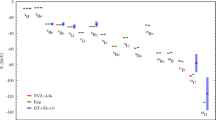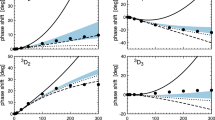Abstract
The low-energy physics of strong interactions suffers from the lack of a perturbation expansion of QCD in this regime. The use of phenomenological models is therefore unavoidable. The models should be based on general symmetry properties of QCD. A SU (3) chiral model for the description of hadronic properties as well as of nuclei and hypernuclei is presented.
Similar content being viewed by others
References
Y. Nambu and G. Jona-Lasinio: Phys. Rev. 122 (1961) 345; 124 (1961) 246.
M. Gell-Mann, M. Levy: Nuovo Cim. 16 (1960) 705.
S. Schramm and W. Greiner: Int. J. Mod. Phys. E 1 (1992) 73.
J. R. Finger and J. E. Mandula: Nucl. Phys. B 199 (1982) 168.
S. L. Adler and A. C. Davis: Nucl. Phys. B 244 (1984) 496.
J. Goldstone: Nuovo Cimento 19 (1961) 154.
N. Isgur and G. Karl: Phys. Rev. D 18 (1978) 4187.
S. P. Klevansky: Rev. Mod. Phys. 64 (1992) 649.
P. Reinhard: Rep. Prog. Phys. 52 (1989) 439.
B. D. Serot and J. D. Walecka: Int. J. Mod. Phys. E 6 (1997) 515.
M. Rufa et al.: Phys. Rev. C 38 (1988) 390.
P. Papazoglou et al.: Phys. Rev. C 59 (1999) 411.
P. Papazoglou et al.: Phys. Rev. C 57 (1998) 2576.
P. Papazoglou et al.: Phys. Rev. C 55 (1997) 1499.
E. K. Heide, S. Rudaz, P. J. Ellis: Phys. Lett. B 293 (1992) 259.
E. K. Heide, S. Rudaz, and P. J. Ellis: Nucl. Phys. A 571 (1994) 713.
G. Carter, P. J. Ellis, and S. Rudaz: Nucl. Phys. A 603 (1996) 367.
R. J. Furnstahl, H. B. Tang, and B. D. Serot: Phys. Rev. C 52 (1995) 1368.
I. Mishustin, J. Bondorf, and M. Rho: Nucl. Phys. A 555 (1993) 215.
P. J. Ellis, E. K. Heide, S. Rudaz: Phys. Lett. B 282 (1992) 271; B 287 (1992) 414 (E).
B. D. Serot, J. D. Walecka: Adv. Nucl. Phys. 16 (1986) 1.
D. T. Spayde et al. (SAMPLE collaboration): preprint nucl-ex/9909010.
D. Zschiesche, P. Papazoglou, Ch. W. Beckmann, S. Schramm, J. Schaffner-Bielich, H. Stöcker, W. Greiner: preprint nucl-th/9908072.
Author information
Authors and Affiliations
Additional information
Lectures given at the Indian-Summer School on Relativistic Heavy-Ion Physics-RHIP'99, Prague (Czech Republic), August 30–September 3, 1999.
Rights and permissions
About this article
Cite this article
Schramm, S. Effective chiral models of nuclear matter and nuclei. Czech J Phys 50 (Suppl 2), 52–71 (2000). https://doi.org/10.1007/s10582-000-0031-z
Issue Date:
DOI: https://doi.org/10.1007/s10582-000-0031-z




